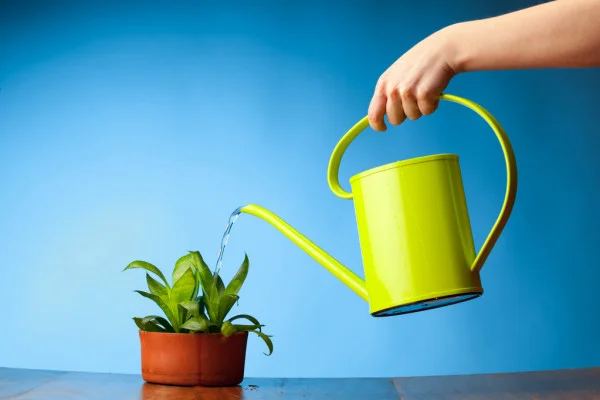Understanding Natural Light for Indoor Plants | Light for Houseplants
Some links in this post may be affiliate links

Light for Houseplants is an important aspect as they require light to make food for growth and survival. The correct light is essential as without light a plant will suffer or even die.
Light is one of the major components required for plants to make their own food for growth and energy.
The process of making food in plants called photosynthesis only occurs in the presence of light energy.
Therefore it is very important to provide houseplants with the correct light amount and intensity to ensure that they are growing and remain healthy.
If you fail to provide adequate light, the plants will grow leggy with elongated weak stems, wide spaces between the leaf nodes and undersized pale leaves, a phenomenon referred to as, 'etiolatation'. Such plants will grow slowly, become stunted and can even die.
To provide the correct lighting for your indoor plants requires that you consider the two aspects of lighting which control growth of plants.
These aspects of lighting are the duration and the intensity of light. We have discussed herebelow, how light affects growth of plants. Keep reading.
The Duration of Light
The duration of light that a plant requires is 8-10 hours per day for most houseplants to maintain active growth.
If there is less light, there is reduced food production which results in poor growth and stunting of the plant.
The Intensity of Light
The intensity requirement varies enormously from plant to plant. Some plants prefer a sunny windowsill, others light shade, others can tolerate direct sunshine while others relish direct sunshine.
Signs of a houseplant that is receiving too little light
If an indoor plant is receiving too little light, it will exhibit the following signs.
- Variegated leaves turn all-green
- Spindly growth with abnormally wide spaces between leaves
- Extremely slow growth or no growth at all
- Lower leaves turn yellow, dry up and fall
- Leaves are smaller and paler than normal
- Poor flower formation or no flowers at all
- New shoots grow towards the light source
If your plants are showing the signs above, move the plants to a brighter spot or invest in a grow light to save them from imminent death. Check out these full spectrum grow lights on Amazon.
Signs of an indoor plant that is receiving too much light
A houseplant that is receiving too much light will exhibit the following signs.
- Leaves have a "washed-out" appearance
- Leaves shrivel up and eventually fall off
- Leaves wilt at midday; when sun is hottest
- Brown or grey scorch patches on leaves
If your plants are exhibiting the signs above, move them to a more shaded spot to prevent them from deteriorating further or even dying.
A Simple Light Guide for Houseplants
In most houseplant care guides the terms used to describe the light requirements may not be clear.
The human eye is a poor instrument for measuring light intensity. This simple guide can help you determine the right spot for your plant. Read on.
1. Sunny Spot (Direct Sunshine)
This is an area with as much light as possible or very bright light with direct sunlight. Such a spot is ideal for plants that can withstand scorching conditions like Desert Cacti, Bougainvillea, Hibiscus, Gerbera Daisy, Pink Jasmine, Snake Plant and ZZ Plant among others.
These sunny spots include such areas as;
- Within 2 feet of a south- or southwest-facing window in the northern hemisphere.
- Within 2 feet of a north- or northwest-facing window in the southern hemisphere.
- A sun room.
- A sunny windowsill.
2. Brightly Lit Spot with Some Direct Sunshine
This is a brightly-lit area with some sunlight falling on the leaves of the plants during the day or what is referred to as bright light with some direct sunlight.
This spot is perfect for many flowering houseplants and some sunloving foliage plants like Saintpaulia (African Violet), Cordyline terminalis (Ti Plant), Rubber Plants (Ficus elastica), Codiaeum (Crotons) among others.
These brightly lit spots with some direct sunshine include such areas as;
- A west- or east-facing windowsill.
- A spot within 3-4 feet from a south- or southwest-facing window in the northern hemisphere.
- A spot within 3-4 feet of a north- or northwest-facing window in the southern hemisphere.
- A partly obstructed south-facing windowsill.
3. Brightly Lit Spot but Sunless
This is an area close to but not in the zone lit by direct sunlight. Here there is no sunlight falling on the plants. This is what is usually referred to as bright, indirect light or bright, filtered light.
Many indoor plants like Monstera deliciosa, Spathiphyllum (Peace Lily), Spider Plant (Chlorophytum comosum), Schefflera actinophylla (Umbrella Tree), Dieffenbachia among others grow best when placed in this area.
These brightly lit sunless spots include such areas as;
- 5 feet around a window which is sunlit for part of the day.
- A large sunless window.
- Within 3-4 feet of an east- or west-facing window.
- 4-5 feet of a south- or southwest-facing window in the northern hemisphere.
- 4-5 feet of a north- or northhwest-facing window in the southern hemisphere.
4. Partially Shaded Spot (Semi-shaded or Medium Light)
This is a moderately lit area. Few flowering indoor plants can flourish here but many foliage plants like Marantas, Dracaena marginata, Dracaena fragrans, Baby's Tears (Helxine), Pothos among others will grow happily. Most of the bright but sunless foliage houseplants can adapt to these conditions.
These partially shaded (semi-shaded) spots include such areas as;
- Within 5-8 feet of a sunlit window.
- Close to a sunless window.
- Directly infront of a north-facing window in the northern hemisphere.
- Directly infront of a south-facing window in the southern hemisphere.
5. Shaded or Low Light Spot
This is a poorly lit area but bright enough to read a newspaper during several hours of the day.
Only a few foliage plants will flourish with the exception of Aglaonema (Chinese Evergreen), Aspidistra (Cast Iron Plant), Asplenium Fern (Bird's Nest Fern), Heartleaf (Philodendron scandens) among others.
Many semi-shade foliage indoor plants will adapt to these conditions and will actually thrive. No flowering houseplant can thrive in these conditions. Check out this list of low light houseplants.
These shaded spots include such areas as;
- Adjacent windows shaded by trees.
- More than 6-8 feet away from a south- or southwest-facing window in the northern hemisphere.
- More than 6-8 feet away from a north- or northwest-facing window in the southern hemisphere.
- More than 5 feet from an east- or west-facing window.
- Hallways, staircases and corners of rooms.
Guidelines for Lighting
- Foliage houseplants require bright light without direct sunlight; most will readily adapt to semi-shade conditions.
- Plants with variegated leaves require more light than those with all-green leaves.
- Flowering plants need more brighter light with some direct sunlight.
- Succulents and Desert Cacti require the highest light intensity of all the indoor plants; they prefer sunny conditions to thrive.
- Keep the windows free of dust to maintain a high light intensity; dust reduces light intensity by upto 10%.
- White or cream-colored walls and ceilings improve lighting by reflecting light in a poor-lit room. A white background will reduce the tendancy of a houseplant to bend towards the light source.
- To prevent lop-sided growth of the plants, turn the pot every time you water; make a quarter turn each time. Do not turn the pot of a flowering plant that is in bud formation.
- Avoid moving a plant from a shady location to a sunny windowsill suddenly; acclimate it by moving to a slightly brighter spot each day.
- You can suddenly move a foliage plant to a shadier spot with no ill-effect. It will survive but will not thrive; move it to the brighter spot for about a week every 1-2 months to allow it to recover.
Note: There are many exceptions to these guidelines. Look up the requirements of your houseplant in the Houseplants A-Z Guide.
You liked it? Share on social media.
Related Content
Amazon Associates Disclosure
Homeplantsguide.com is a participant in the Amazon Services LLC Associates Program, an affiliate advertising program designed to provide a means for sites to earn advertising fees by advertising and linking to amazon.com.


